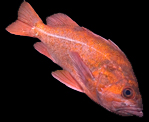
California hydrocoral, Stylaster californicus
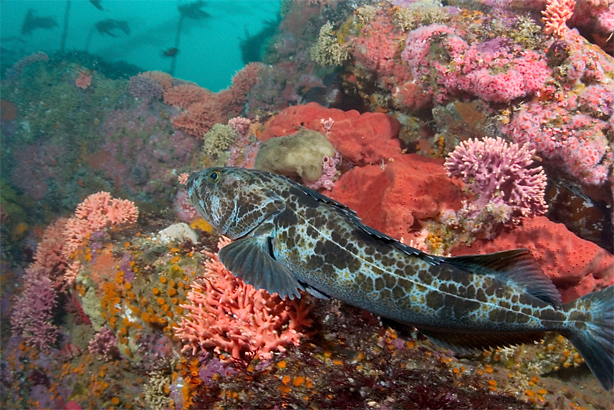
Being ambush predators, lingcod (Ophiodon elongatus) are relatively
tolerant of curious photographers. However, a fish that just sits on the bottom
often makes for a pretty boring picture. Thankfully, lingcod behavior is rather
predictable. With a little luck, one may be able to steer a ling into a desired
posture. This is one of my more successful examples of this. The biggest
challenge with such shots is getting the focus point correct. I have drawers
full of blurry lingcod pictures that I'm not going to show you. Another
difficulty when taking this kind of shot is that you usually only get one
chance. After that, the subject is sufficiently annoyed that you're going to
have a hard time getting close enough.
"East Pinnacles", Carmel Bay, California
January 23, 2005
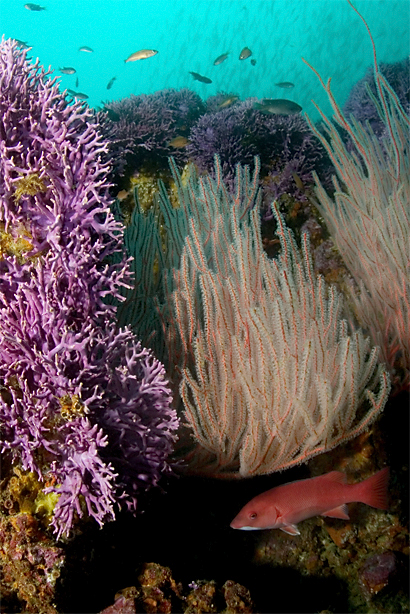
As is typical of wrasses, California sheephead (Semicossyphus pulcher)
begin life as females, but may transform into males in later life. Here, a
demure female seeks the shelter of a red gorgonian (Lophogorgia
chilensis). It's a several hour ride from Los Angeles harbor to Farnsworth
Bank. The long ride, coupled with the time the night before spent in heavy I-5
traffic rather than sleeping, took its toll the day I shot this image. In fact,
I can't ever remember being more miserable out on the water. The day's dives
themselves were clumsily executed, but enjoyable nonetheless. The end of the
second dive coincided with the start of distressingly brisk wind which made the
trek to the night's anchorage a long one. The ascetic accommodations on the
whaler'sanchor locker were never more welcome.
"Farnsworth Bank", Santa Catalina Island, California
April 2, 2005
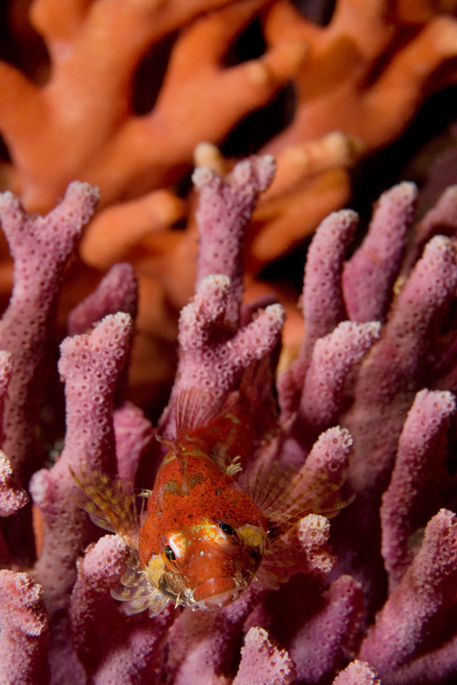
A scalyhead sculpin (Artedius harringtoni) that appears to be fairly
adept at crossing its eyes. This animal's camouflage is defeated by the backdrop
of California hydrocoral (Stylaster californicus). However, there is an
abundance of potential prey hiding within the hydrocoral branches which may make
the risk of venturing out into plain view one worth taking.
"East Pinnacles", Carmel Bay, California
October 8, 2006
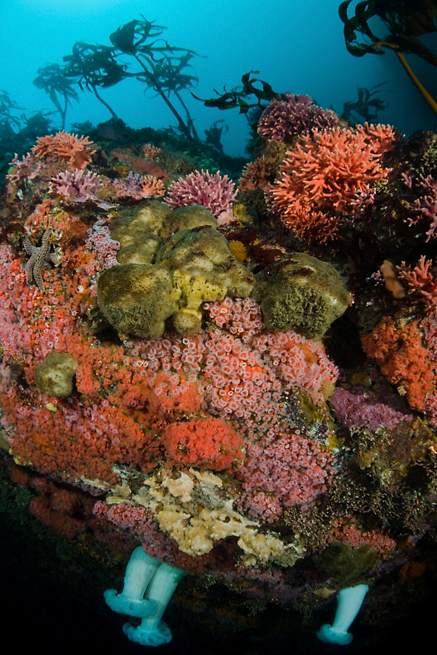
Up or down? Having been quite disappointed by Canon's 15mm fisheye lens, I
picked up Sigma's version. So far, it looks like the new toy adapts to
underwater life much better than does the Canon. I suspect there will be a used
Canon fisheye going up for sale on eBay soon. This shot contains nothing more
than the usual Carmel Bay subjects: California hydrocoral (Stylaster
californicus), Corynactis californica, and Metridium farcimen.
However, I like it because of the lighting -- actually, the lack of lighting in
the bottom of the shot and that the Metridiums don't seem to need any
illumination to show up just as saliently as they always do. It almost seems
like the bottom of the shot is some sinister complement to the heavenly blue
water at the top. I suspect this picture wouldn't have been nearly as successful
if taken on a day when Carmel Bay's water was its more usual green.
"Outer Pinnacles", Carmel Bay, California
January 28, 2007
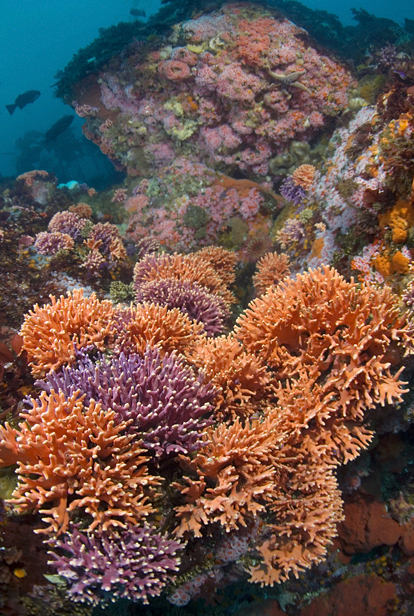
I love the way California hydrocoral (Stylaster californicus) spills over
this ledge. This is surely the shot that took the most attmepts before achieving
a presentable image. It doesn't look like a particularly difficult subject, but
the combination of turbulent water and the somewhat problematic geometry led to
a string of disappointing pictures. Interestingly enough, another photographer's
picture of this same patch of coral was one of the driving forces behind my
decision to take up underwater photography. And, coincidently, I acquired my
first housed camera from that photographer's spouse!
"East Pinnacles", Carmel Bay, California
May 15, 2006
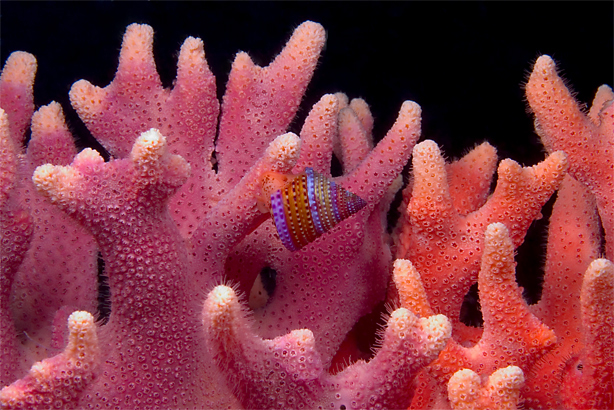
Jewel top snails (Calliostoma annulatum) are one of the many animals that
can be found in the branches of California hydrocoral (Stylaster
californicus).
"Forgotten Pinnacle", Carmel Bay, California
December 11, 2004
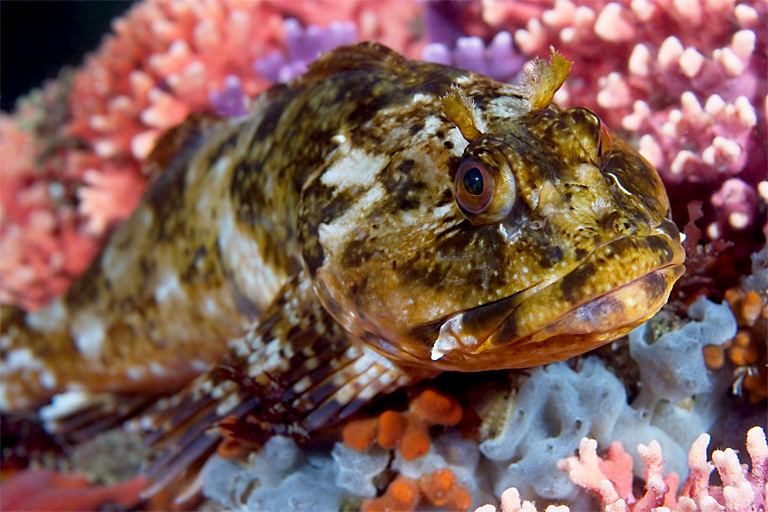
Cabezon (Scorpaenichthys marmoratus) rely heavily on camouflage. This
one, however, is easily spotted against a backdrop of California hydrocoral
(Stylaster californicus). These fish have something of a split
personality. Frequently, they bolt in terror when a diver is as much as 30 feet
away. At other times, even when it's quite obvious they've been spotted, they
seem perfectly happy to be an object of close inspection. Some of the most
extreme examples of this latter behavior occur in the early part of the year
when males establish their nests. The animal pictured here was not keeping watch
over eggs, but nonetheless seemed content to stay put. In July, when this
photograph was taken, East Pinnacles is overgrown with Eisenia and other
algae. This makes both finding interesting subjects and taking photographs a bit
more challenging. To take this particular shot, the photographer had to hold
back a bouquet of Eisenia fronds with his forearm at the same time as he
was positioning the camera and illuminating the subject with a cannister light.
It was more than just a little frustrating and was, in fact, the last straw that
led to the purchase of a real focus light which presumably allows for such
pictures to be taken while using only two hands instead of requiring three.
"East Pinnacles", Carmel Bay, California
July 17, 2005
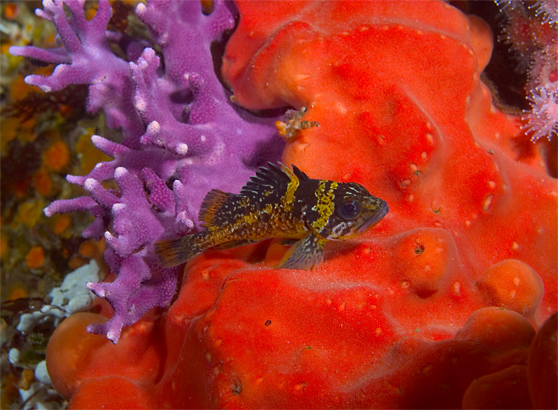
A young China rockfish (Sebastes nebulosus) nestles between a colony of
California hydrocoral (Stylaster californicus) and an unidentified red
sponge. One could say that this picture was actually several months in the
making. I had my eye on this sponge and hydrocoral colony for quite some time.
It's a striking background, but doesn't appear to be a particularly popular
hangout for interesting foreground subjects. Eventually, one day sunny July day
with pedestrian water clarity I ran across this cute little China. It should
have been a fantastic opportunity, but the heavy surge and the animal's
exceptionally skittish disposition made things difficult. The hole this guy was
using as refuge provided excellent protection from the glaring strobes of
inquisitive photographers, however it lacked a hideaway small enough to keep out
a lingcod or other predator. This might explain why I've not run across this
fish since my initial encounter. Interestingly enough, little is known about the
habits of juvenile China rockfish. In fact, there seems to even be some debate
about what very young ones even look like!
"East Pinnacles", Carmel Bay, California
July 16, 2005
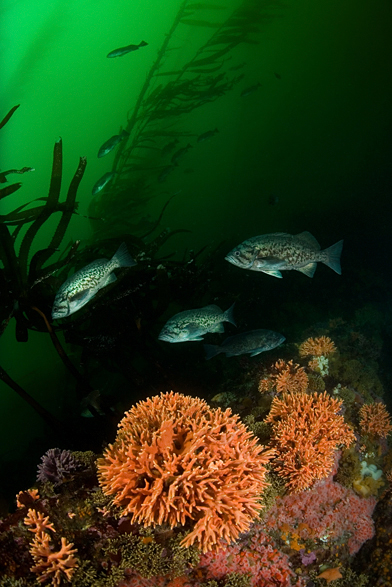
California hydrocoral (Stylaster californicus) and blue rockfish
(Sebastes mystinus). Like many of us, blue rockfish are fairly averse to
doing more work than they need to do. The fish in the background of this shot
are hiding in the lee of a stalk of kelp so that they don't have to swim against
the current. It might seem surprising that a fish would need to do this.
However, your average reef fish isn't really built for long extended swims. And,
of course, rockfish seem to spend a great deal of their lives running away from
the local pinnipeds. I imagine they appreciate the odd opportunity to take it
easy for a bit.
"Outer Pinnacles", Carmel Bay, California
August 20, 2006
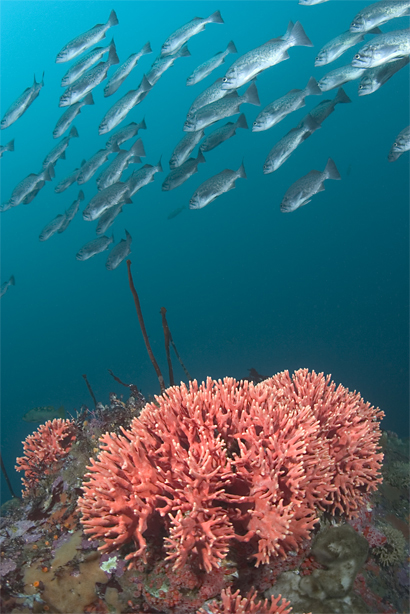
California hydrocoral (Stylaster californicus) and blue rockfish
(Sebastes mystinus).
"East Pinnacles", Carmel Bay, California
January 22, 2006
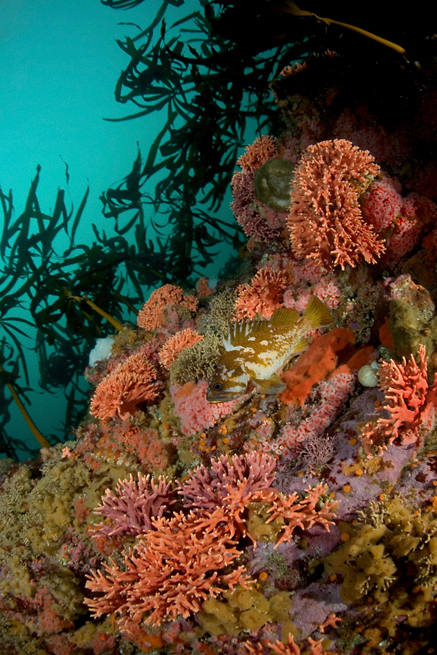
A gopher rockfish (Sebastes carnatus) followed me around with the
expectation that I'd stir up something good to eat. This common fish behahvior
always gives me pause. One wonders if the fish would follow any large animal or
if one has given it reason to beleive one will be crashing in to things. A sure
way to stop such an unwanted shadow is to point a camera at it. This fish was
quick to dart into some California hydrocoral (Stylaster californicus).
"Local's Ledge", Carmel Bay, California
September 30, 2006
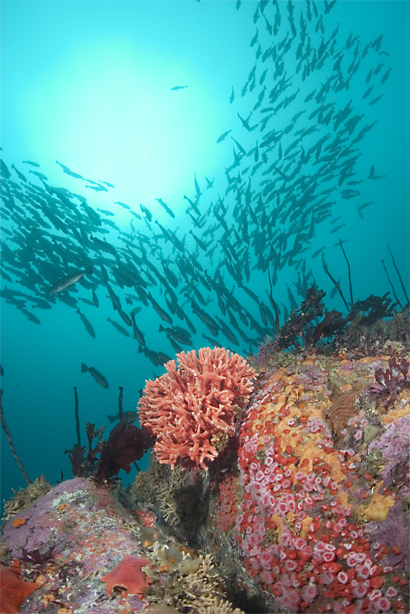
California hydrocoral (Stylaster californicus) and blue rockfish
(Sebastes mystinus) cradle a sunburst. When shooting wide angle, cold
water photographers often prefer to look directly at the sun like this. While
the photographer may get a little bleary-eyed watching a backlit scene, the
camera's autofocus appears unaffected. The increased background light makes it
easier to achieve a picture with balanced lighting.
"East Pinnacles", Carmel Bay, California
January 22, 2006
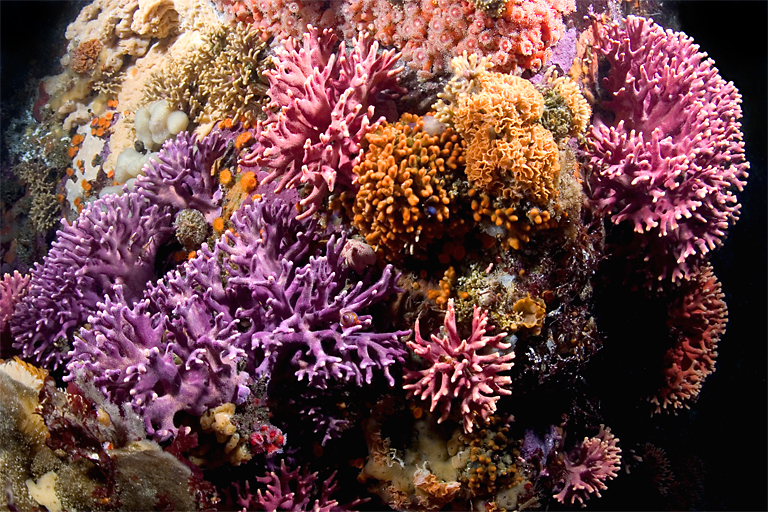
California hydrocoral (Stylaster californicus) is usually found in places
with high current or surge. Like many hydrocoral pictures, this one was taken
as a "fly by" as the photographer rode the surge in a narrow channel between two
boulders.
"East Pinnacles", Carmel Bay, California
December 18, 2004
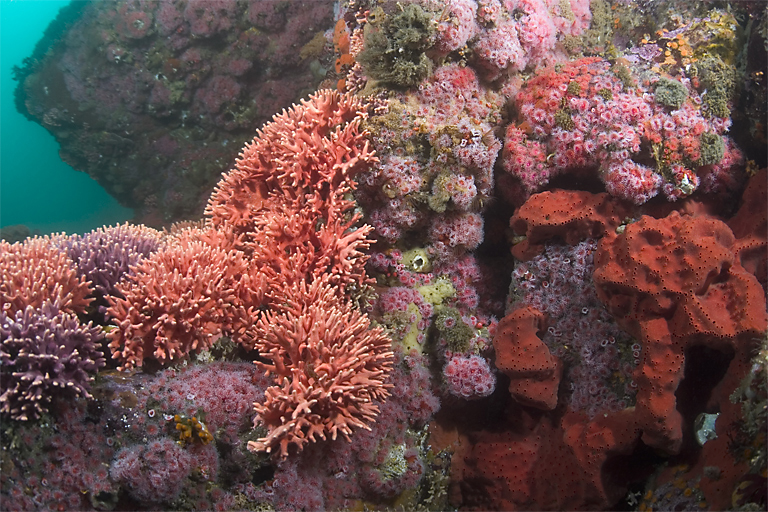
This pocket of California hydrocoral (Stylaster californicus) extends
well beyond the edges of this photograph. It's easy to spend an hour or more
here, floating motionless as the surge sweeps you back and forth across the
pocket's features.
"East Pinnacles", Carmel Bay, California
February 12, 2005
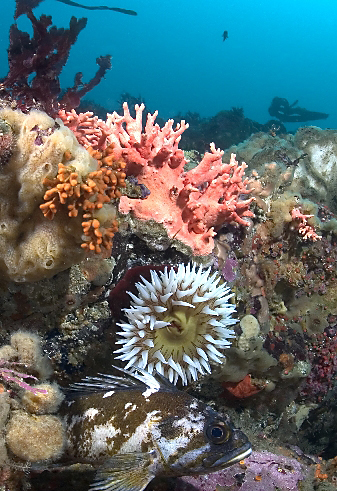
Fish-eating anemone (Urticina piscivora) and gopher rockfish (Sebastes
carnatus) under California hydrocoral (Stylaster californicus.
"Forgotten Pinnacle", Carmel Bay, California
December 15, 2004


















